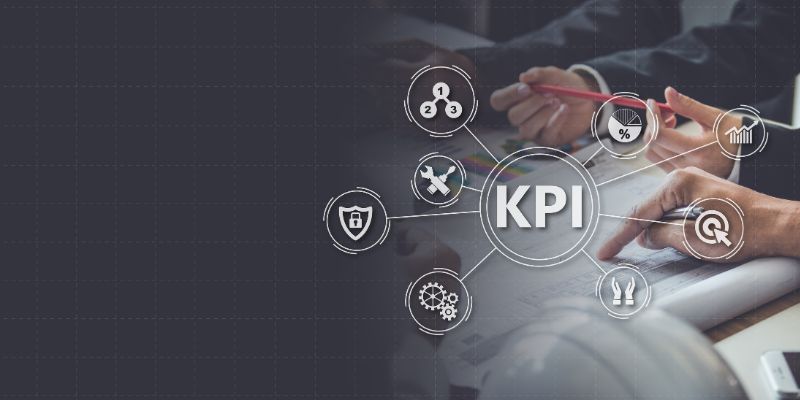Every company should have a website. And all business websites should strive to support your goals! If you have a new website and you don’t know if it’s right for your project, we’re here to help. Let’s take a look at the key KPIs to measure site performance.
Why is Website Measurement Important?
Just like regular medical checkups, you need to monitor the health and performance of your website to ensure it is doing everything you hoped and dreamed of. An overhyped and overlooked website can easily become less of an asset and more of a problem.
Think about the last time you visited a site and it wasn’t necessary or made you feel so bad that you left and regretted not looking at anything. Would you visit the site again? Not at all. Issues related to SEO, usability, and content can reflect poorly on your brand.
So I recommend setting up your data and checking it regularly to measure your site’s performance. You can use a Google Analytics data menu or create a visual tool like DashThis to aggregate data from multiple sources.
What are the Goals of a Good Website?
To measure your site’s performance, you first need to define what you want to achieve. That way, every piece of your data serves a specific purpose. What are the best things a visitor can do on your site? These can be your goals. Many websites use generic KPIs. Everyone wants their website to offer an easy and fast user experience, right?
These are the main goals of the website:
- Increase traffic (total and per source)
- Increase dwell time (time on page).
- Fast page load times
- Attract new customers
- Earn links
- Rank well in the search results.
The specific KPIs you use to measure website performance depend on your business. Now let’s talk about how to measure these performance goals and more!
12 Ways to Measure Website Performance
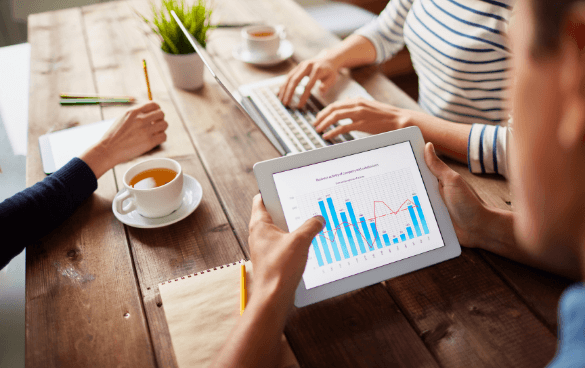
Before starting, we recommend that you use at least two months of data in Google Analytics or another tracking tool of your choice.
Many factors can cause data to rise and fall, from campaigns and bot movements to Google algorithm updates, holiday or seasonal search services, and global disasters. It is therefore useful to compare data from different years. The July data from one year is more accurate compared to July and June of the previous year. However, if your new site doesn’t have annual data yet, it’s best to use the following monthly numbers to track growth and declines.

Measure your website’s performance with Google Analytics.
These are the easiest and most free ways to analyze your website using only the default Google Analytics dashboards that open when you log in. It’s a great way to quickly look at key traffic and engagement metrics.
1. Total Website Traffic
More traffic is almost always a top goal. More website visitors means more chances of conversion! You can quickly see your website’s overall traffic in Google Analytics under Audience > Overview. Simply select a date range and compare (last season or last year), and you will see if there is an increase or not.
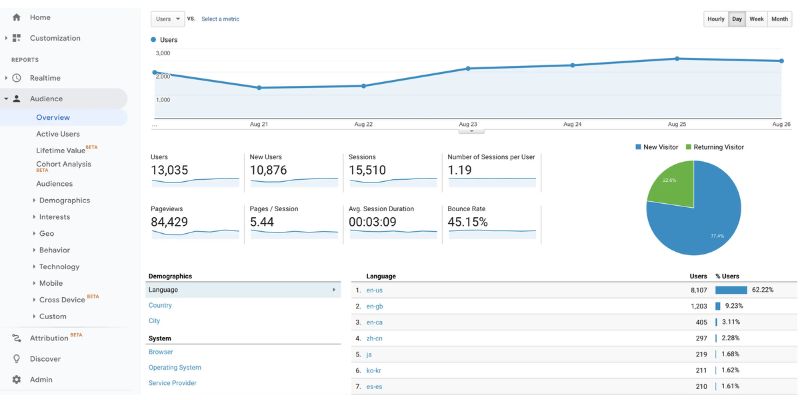
Sessions are the total number of times your site has been visited. Users are just your guests; some people have visited two or more times, so the two numbers are usually different.
2. Visitor Engagement
You have a lot of visitors to your website, but what exactly did they do? To get a general idea of audience behavior, view your traffic statistics directly in Audience > Overview.
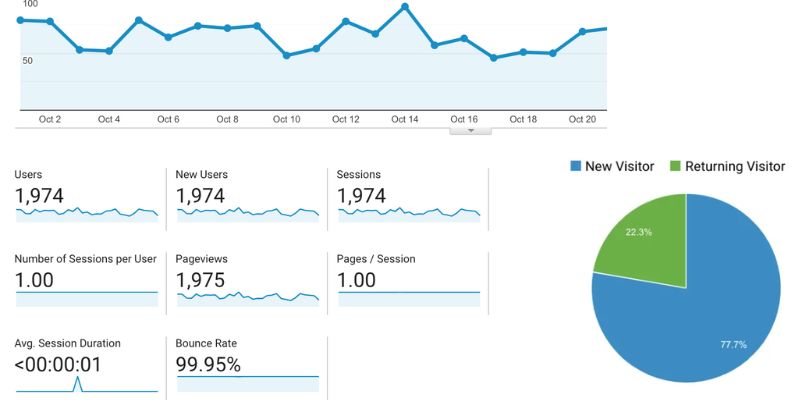
- Pageviews are determined for all pages viewed in your chosen date range.
- Pages per session measure how many pages a person has viewed in a given period.
- The average session duration reflects how long people spend accessing your content.
- Bounce rate measures the number of visitors who leave (bounce) without doing anything and follow the page as if they had seen it for zero seconds; that is, they saw the landing page and were able to scroll through it, but did not click on it.
Pages per session and session duration encompass bounced sessions. If your bounce rate is 52%, that means 52% of your sessions are recorded as zero seconds and page views, which factors into your averages and drags them down. Google Analytics is such a steal.
3. Traffic by Source
Keep in mind that not all visitors contribute positively to your website. For instance, nobody likes getting visits from spam and bots. Also, you might notice an overall increase in traffic that comes solely from an advertising campaign, while the traffic from online searches goes down. This decline can indicate issues with your website’s search engine optimization (SEO). That’s why it’s important to examine the traffic according to its source. You can find this under Acquisition > All Traffic > Source/Medium.

In this section, you will discover a breakdown of traffic categorized by individual search engines (not limited to Google alone!), social networks, referral sources, ad types, and other relevant factors. You can view engagement data for each traffic source. In addition, with configured goals, you can identify the sources with the highest and lowest conversion rates.
4. New vs. Returning Visitors
If your business is still building a brand, you can focus on reach and awareness. Attracting new visitors to your website can be a great goal. However, if your website has a lot of assets like blog posts, white papers, and downloads, the number of returning visitors can be an indicator of success.
This important data can be found under Audience > Behaviour > New vs. Returning.
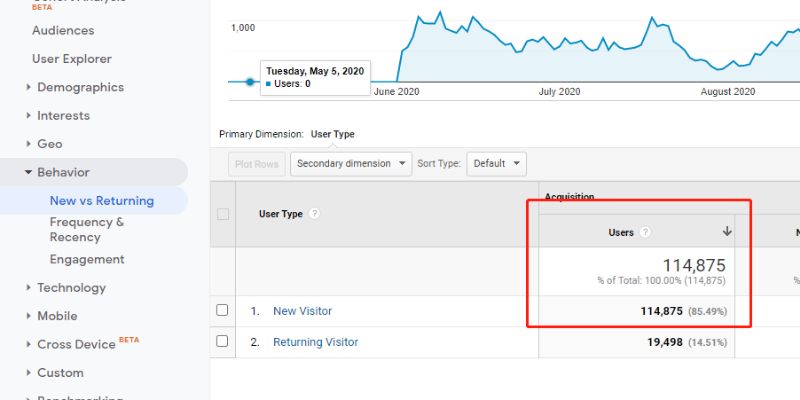
Returning visitors is also a good thing for B2B websites, as it often takes more than one look at your services, case studies, and pricing to make a B2B buying decision.
5. Dwell Time
Remember how I said Google Analytics collects ads over time? If you want to know how much time people spend viewing your content, the answer is Dwell Time or the average time spent on a page.
Average page time excludes bounced sessions. So although 52% of your website traffic is still missing from this data (if your bounce rate was 52%), it’s more important than the average session duration because all sessions with zero duration are not impacting your numbers.
You can find the session time for each page on your site under Behaviour > Site Content > All Pages.
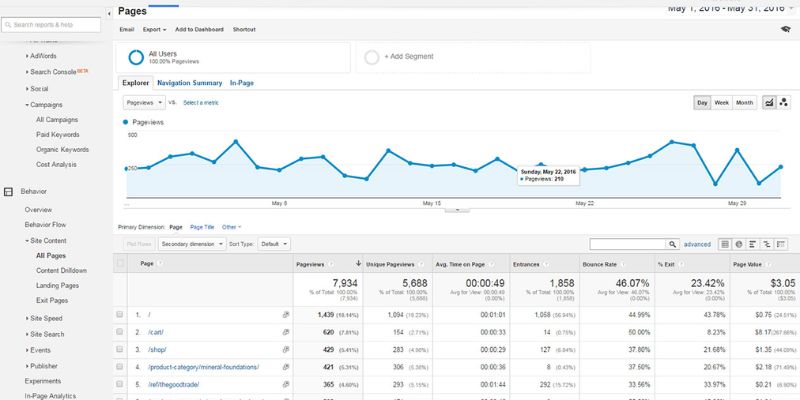
The ideal dwell time for a blog post or research article may be longer, depending on the length of the article. However, for pages that require a good user experience (such as a landing page or a contact page), you should expect a short time.
6. Google Analytics Events
As a boss, if you want to measure the performance of your website, you need to monitor all activity on your website to reflect its performance. Google Analytics can be configured to record these small interactions via events. An event can be almost anything that shows your audience is interested in what you have to offer.
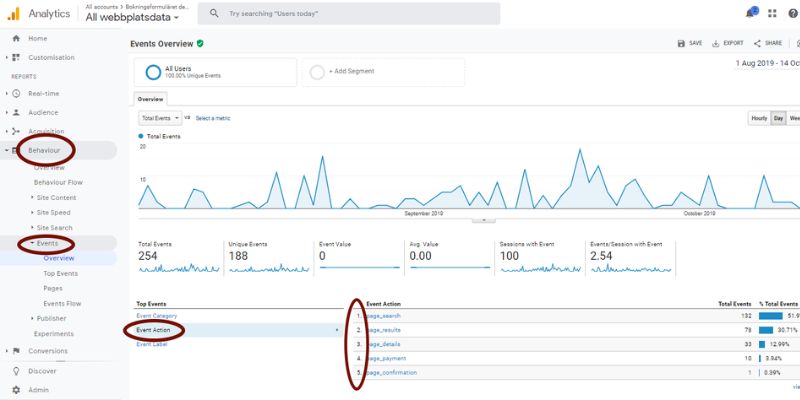
Here is a short list of popular steps and links to tutorials on how to use Google Tag Manager.
- Video plays, pauses, and percentages
- Downloads
- Outbound link clicks
- Clicks on buttons, like ‘where to buy’ or ‘buy now’
- Email newsletter opt-ins (track the submit button and click as above)
- Click to launch a phone call, email your company, or get directions.
- Clicks to schedule a demo, initiate a free trial, or request a table (these are also click events specific to each button)
- Form submissions
- Click to check out your social profiles by using the icons on your footer or contact page.
Another popular event is scroll depth’, which tracks how many people scroll down 25–100% of your page. Compared to the average time spent on a page, this can greatly determine the quality of your content!
7. Google Analytics Goals
Google Analytics focuses on actual conversions: registrations, sales, or submissions. These often indicate that a sale has been made or a lead has been received, but some businesses or nonprofits may place more emphasis on session length and content download.
Goal completions are a very important way to measure website performance because they give weight to other information, such as traffic sources or visitors from certain cities. Goals are set in the admin dashboard and can be viewed in Conversions > Goals > Overview.
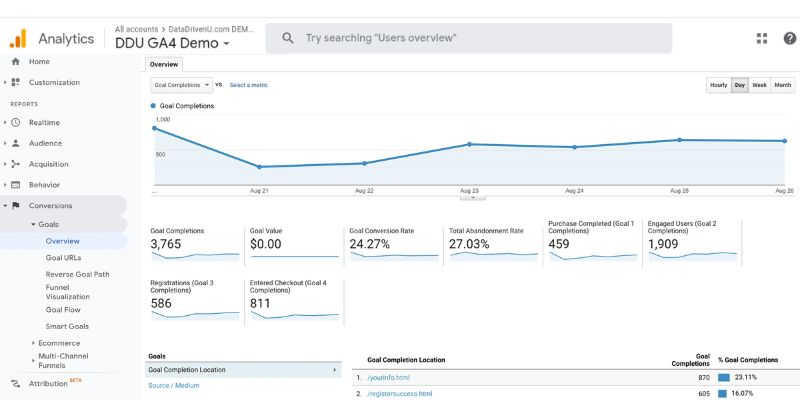
Events are tracked by time and goals per session. If a visitor completes a goal three times during a session, this will only be recorded once in Google Analytics. But by default, goals are automatically displayed in the column next to most of the information in the graphs, showing the amount and conversion rates.
You can also determine where a visitor viewed a particular page. This is especially useful if you have a thank-you page that everyone can see. It also helps if a visit to your website page results in a valuable customer.
8. Site Search
If someone takes the time to find something specific on your site, they will be closer to conversion and still see the page faster. If your website has a search engine, you can use it in your admin panel.
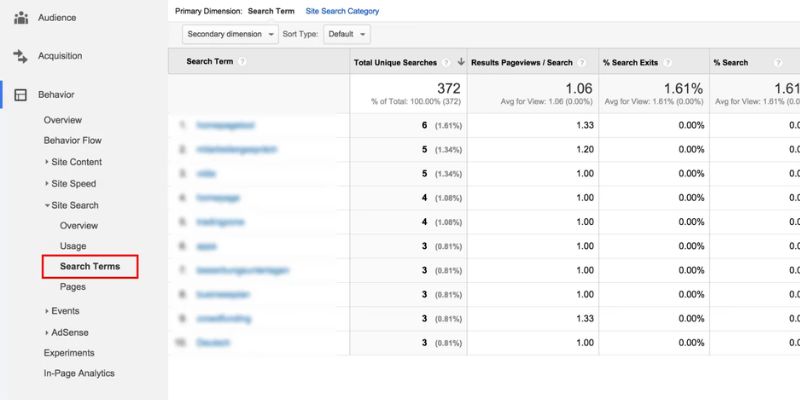
Web search results help you measure both the effectiveness of your UX design and the interests of your audience. If people are still searching for keywords that return nothing relevant, you may need to move them to something more detailed. They also have a quality search engine for blog topics or interesting products.
This can be used to influence new content, new products, and even your website design. If you notice that visitors are researching a specific topic each July, you can be sure to publish new content on that topic or showcase products when people are ready to buy more.
9. Keyword Rankings
Your position in search results reveals your website’s SEO strengths and weaknesses. That’s why it’s wise to always check what searches your site is ranking for and how you’re doing.
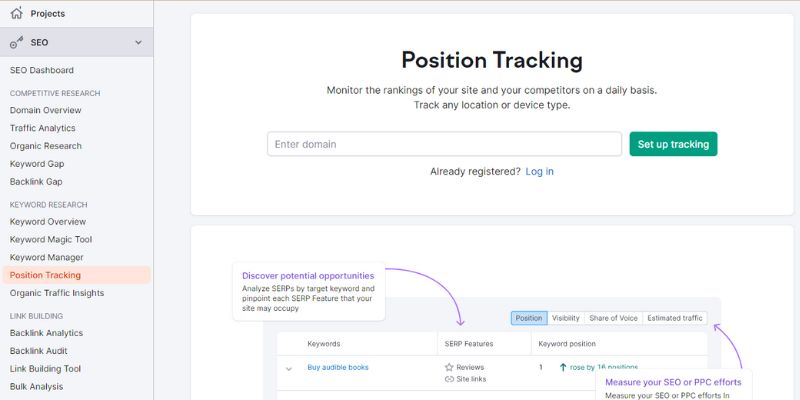
There are many powerful SEO tools you can use to monitor your keyword rankings, and most of them allow you to track a limited number of results with a free account. At webdotnine, we use SEMRush to quickly collect important data for our website and our clients’ websites.
You can see information about your page rank and position, as well as useful information like how hard it is to rank organically for that keyword. You can then schedule site improvements and new content to improve your ranking or rank for terms not on your list.
10. Site Speed
Page load time affects your user experience and has a big impact on Google rankings. Slow-loading pages often cause visitors to leave without visiting your site, which is bad for your business. Therefore, you should always consider site speed when measuring performance.
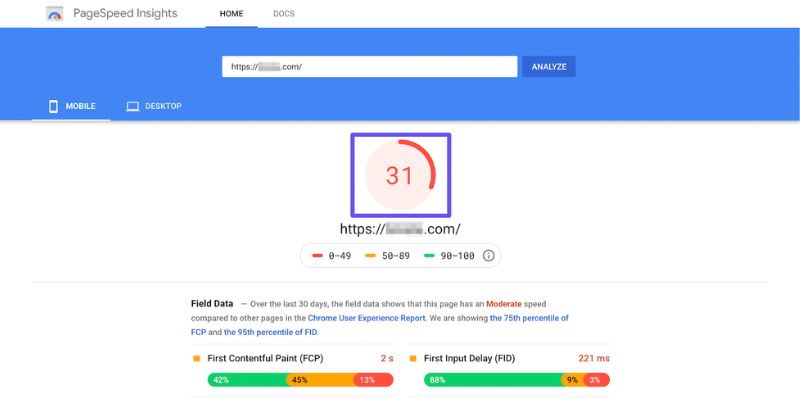
This information is available in Google Analytics, but we recommend using a free online tool such as Google PageSpeedInsights or GTMetrix. These tools not only tell you how your URLs are behaving, but they also give you tips on how to make them faster!
11. Earned Links
We’ve already discussed several ways to measure the effectiveness of your content: dwell time, scroll depth, page ranking for keywords, and engagement within the page (outbound or internal link clicks, video plays). Link building is also an important part of ranking your website and content, so links are a good indicator.
Links from other sites share their SEO juice; Google bots find links from other websites and go to your website. Link text helps Google understand how and why you link to a topic on their page and helps you manage the relationship effectively. The best links come from the most trusted sites, such as those ending in.edu and.gov, because if they trust you, you are a true professional.
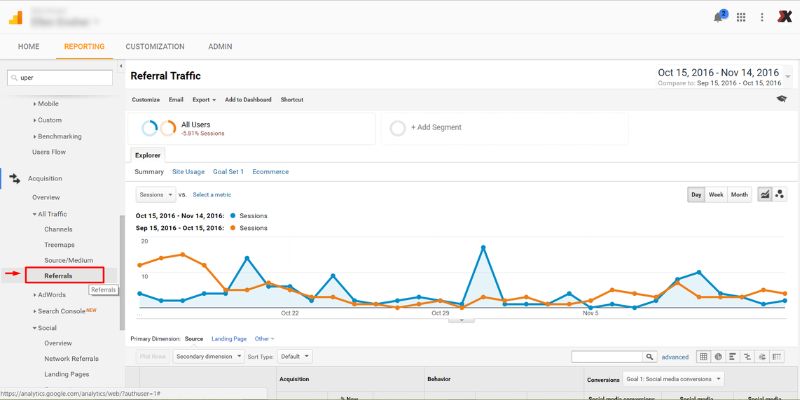
You can see referral traffic in Google Analytics under Acquisition > All Traffic > Referrals.
You can also use an SEO tool like SEMRush to analyze your link profile, remove links from low-quality sites that may be toxic, and get affiliate marketing ideas.
12. Social Media and Email Data
Just like with keywords, you can learn a lot about the quality of your content by using data from social media and email campaigns. While comments and shares can help, we’re talking specifically about clicks.

Social media on your website helps you evaluate the relevance and effectiveness of the content you publish. You can search for individual headlines and meta messages (social media) or headlines and teasers (email) to see what gets the most clicks.
We hope this list has helped you to start analyzing your website! Measuring its effectiveness depends on your business and the unique needs of your target audience. The most important KPIs are the ones that reflect your business goals.
